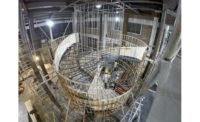"We do a lot of work that needs to be scheduled hour by hour or day by day to prevent clients from losing millions," says Matthew.
Graycor's ongoing installation of a selective catalytic reduction system at a generating station near Sheboygan, Wis.—a $154-million project for Madison, Wis.-based Alliant Energy Corp. intended to meet new state regulations for emissions control—requires that plant employees access equipment in heavy construction zones. "Thus far, [Graycor] succeeded in ensuring that construction doesn't impact operations and that operations don't impact construction," says David de Leon, director of strategic projects for Alliant Energy.
"These are not the types of projects that grace the cover of ENR," Steven acknowledges, "just projects that address the problems clients encounter every day. That's why much of our business has been recession-proof. Clients can't defer certain types of work until the economy improves. "
Although Graycor revenue soared 44.5% to $497 million in 2011, it's a feat the Gray brothers quietly shrug off. "We had a dip in 2010 and came back in 2011," says Steven.
"We're on a generational march," adds Matthew. "We're not a quarter-to-quarter or year-to-year firm."
High Performance
As such, Graycor continues to reshape itself according to the greater evolutionary forces in the industry, including an increasing emphasis on quality, scheduling and coordination, particularly on heavy process-oriented projects. These circumstances prompted the firm to acquire expertise for self-performing so many crafts that Matthew finds it easier to describe the ones it doesn't do.
"We don't do electrical, insulation or roofing," he says. "But [self-performing our trades] has blossomed nicely for us in the past five to 10 years. And it's really been client driven. We've self-performed 3.5 million craft hours in the industrial sector, including concrete, steel, mechanical and pipe-fitting, which comes into play with our work in refineries and food and chemical plants."
Other changes, including the ongoing churn within the petroleum and power segments, are more difficult to chart, though Graycor is preparing for any number of outcomes. "Our involvement in that segment is going to be situational, meaning we're going to need to respond to the very particular criteria of a given state, jurisdiction or system," says Matthew.
In the petroleum and process markets, the firm continues to benefit from ongoing modifications to better equip refineries for processing heavy crude oil sands, though most of that work is nearly over. Meanwhile, Graycor is eyeing opportunities arising from shale gas formations, though Matthew acknowledges those opportunities have been limited to date. "I think we'll eventually see that market become a reality," he says.
A more immediate issue Graycor and other builders face is recovery fallout from the protracted downswing.
"Two million workers have left the industry, and many of them aren't coming back," says Matthew. "If you intend to be here in 10 years—and we intend to be—there is a desperate need for training. We're involved in more training than ever. We try to be long-term thinkers."


















Post a comment to this article
Report Abusive Comment